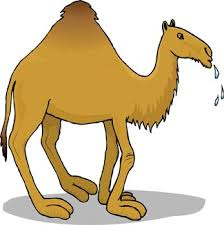Due to my daughter’s
surgeries (her fifth on her right femur last week and the sixth scheduled for tomorrow) I am caught unprepared and am recycling the first post ever to appear
in Sweethearts of the West. As a giveaway, I will give an e-copy of the first book
I had published, BE MY GUEST.
Since I live in, write about,
and love Texas, you won’t be surprised to learn that today’s post involves
Texas and Southwest history. If you saw the 1976 family comedy “Hawmps!,” then
you already know that the U.S. Government experimented with the effectiveness
of camels in the desert West. The movie was hilarious, but loosely based on
fact.
 |
| Jefferson Davis Secretary of War in 1855 |
In 1855, the U.S. Congress,
at the urging of Secretary of War Jefferson Davis, authorized the importation
of camels and dromedaries to be used for military purposes and earmarked thirty
thousand dollars for the experiment. Davis, a veteran of the war with Mexico,
had seen considerable service in the Desert Southwest. Keenly aware of the role
that camels had played over the centuries in the warfare of other nations, he
believed that the strange beasts could be put to use in the United States as
well.
Major Henry C. Wayne and
Lieutenant David D. Porter departed for North Africa, where they were met by a
third American, Gwinn Harris Heap, whose father had been the U.S. consul to
Tunis for a number of years. They acquired thirty-three camels before departing
for home in February 1856. Native camel drivers accompanied the camels and
dromedaries.
The ocean voyage from the
Mediterranean, through the Strait of Gibraltar, and across the Atlantic was
been uneventful considering the fragile cargo. On May 14, 1856, the camels came
ashore at Indianola, Texas. Ten acres of land had been set aside for them and a
two-hundred-foot-long shed had been built to house them. Major Wayne decided
first to acclimate the camels to the intense humidity of the Gulf Coast by
letting them rest in a large corral.
Writing to Secretary of War
Jefferson Davis, Navy Lieutenant Porter said, “We have lost on the voyage but
one of those we purchased…and she died from no want of care, but because she
was unable to produce her young one…We still have more than we started with,
some young ones having been born on the passage, and are in fine condition. All
the other camels I am happy to say have not received a scratch…They are looking
a little shabby just now, most of them shedding their hair…but they are fat and
in good health.
Three weeks later, the
animals began first leg of the trip that would take them to San Antonio, Texas,
on to El Paso, Albuquerque, and across the arid Southwest all the way to Fort
Tejon, California. The camels performed extremely well. Capable of carrying
loads of up to twelve hundred pounds—larger than a horse or mule could
carry—the beasts lumbered along at a slow but steady pace.
A
monument in Quartzite, Arizona pays tribute to chief camel driver, Hajid Ali,
called Hi Jolly. After the camel experiment failed, he used some of the
released camels to conduct a freight business. Later he married and worked in
Quartzite. The monument is at his last campsite. At his death, he believed
small families of camels still roamed in remote areas of the Southwest.
The great camel experiment
eventually failed. With the advent of the Civil War, the personnel at Union
garrisons in the Southwest scattered before the advancing Confederates. Some of
the imported animals were set free and some were kept in captivity. The last
known survivor died in a Los Angeles zoo in 1934. However, even today people
occasionally tell tales of seeing lone camels in remote corners of the Southwest.
My giveaway is an e-copy of BE MY GUEST or another of my books if the winner prefers.
Note: Most of this info was
gleaned from an article in his book IT HAPPENED IN TEXAS, by James A.
Crutchfield, 1996, Two Dot Press, Helena, Montana.






I remember stories and article about the camels. It's kind of a funny story...and what I call "a good idea on paper."
ReplyDeleteIs your book in a new series--Texas Caprock Series? I don't think I've seen this, but what a great title..I grew up on the Caprock, and you and I are the few who know what that is.
The cover is perfect--good luck!
Celia, you win a copy of the book. This is set at Post, just below the Caprock. The sequel will be our in May.
DeleteI knew we had camels, but not what happened to them or why we stopped using them. Thanks for a fun info!
ReplyDeleteWhat an interesting article. I had heard there were camels imported into the west, but I never what became of them. I like the idea that, just maybe, they're still out there in some remote area, healthy and happy.
ReplyDeleteGreat blog, Caroline.